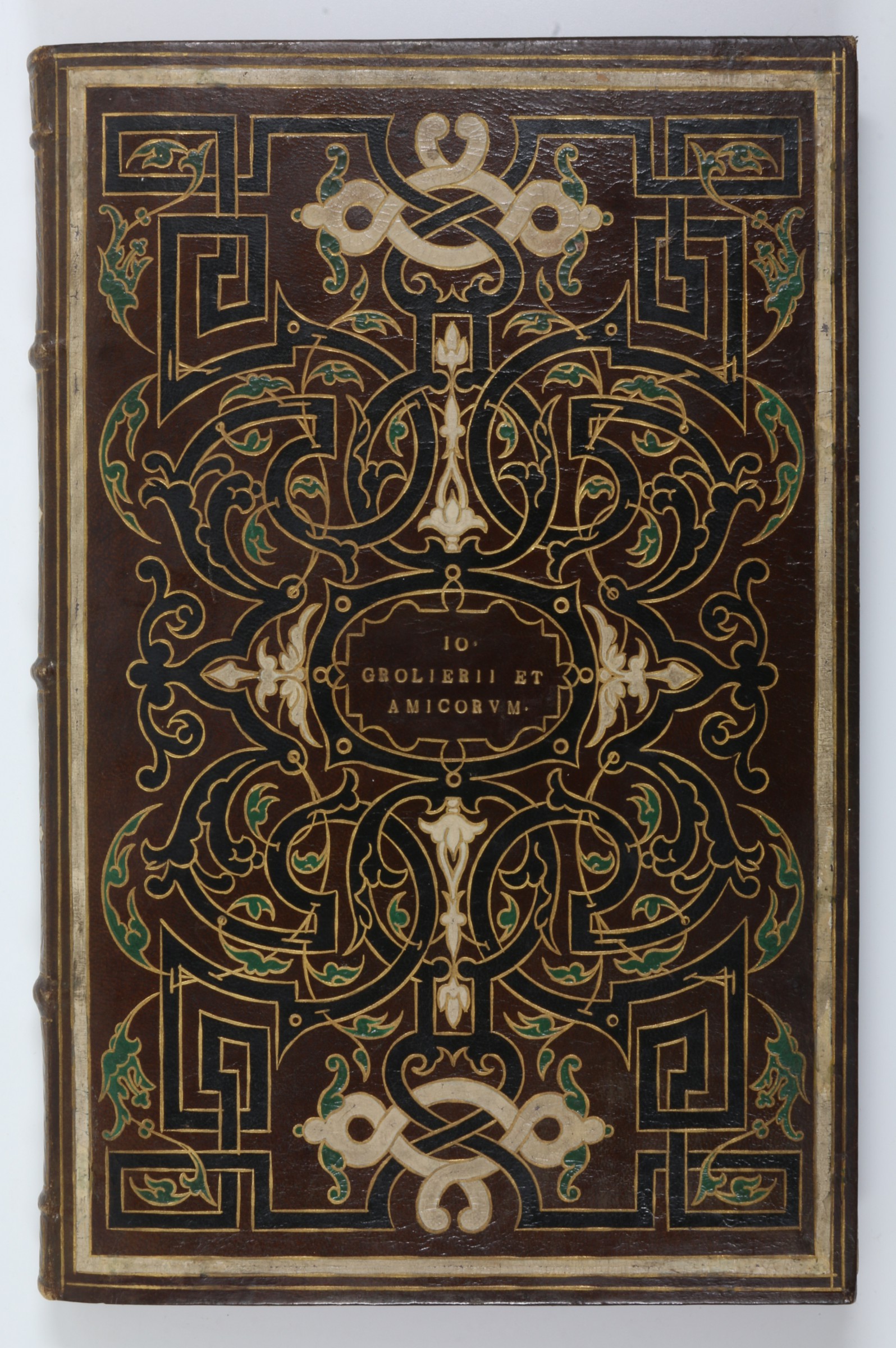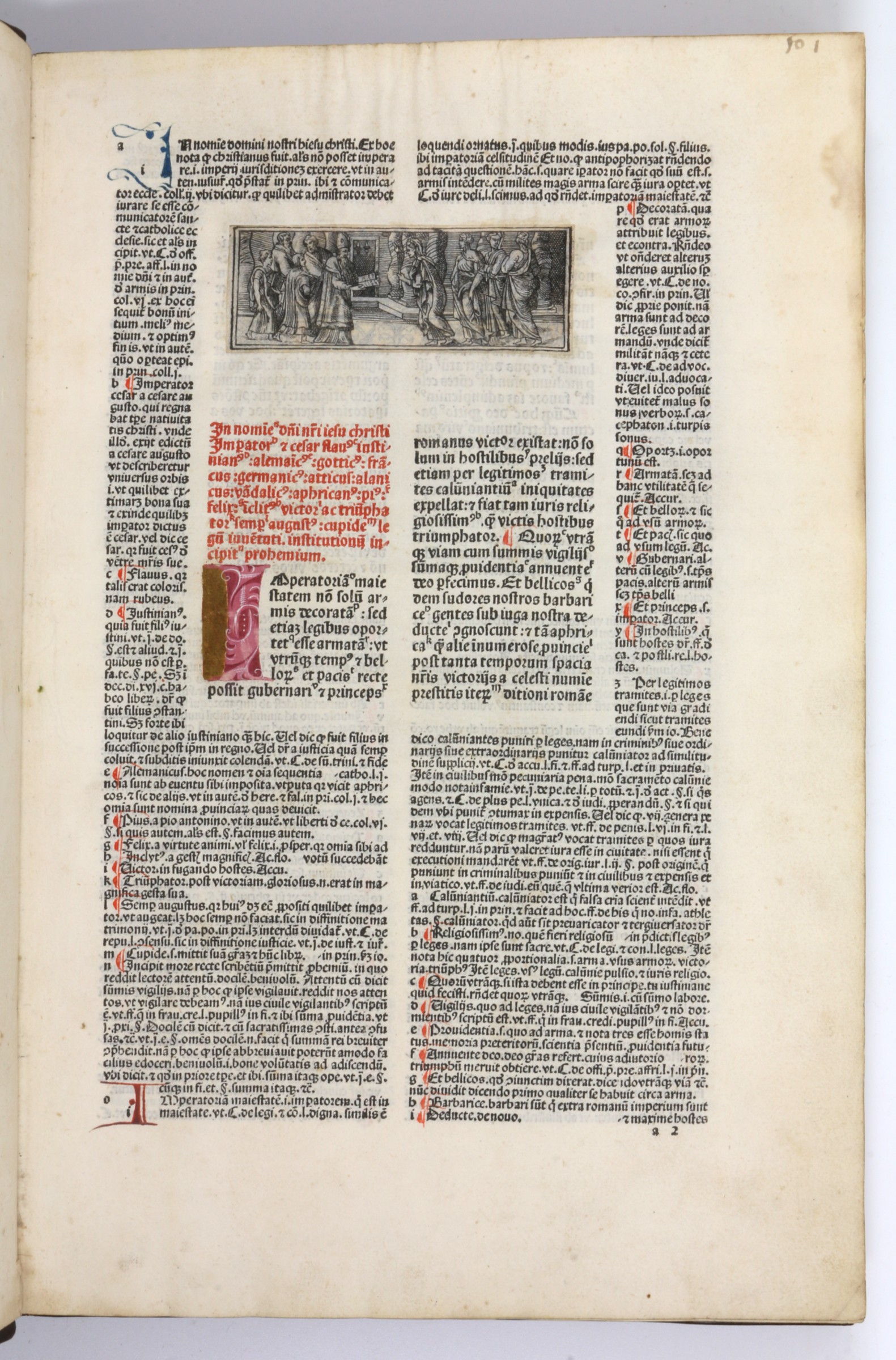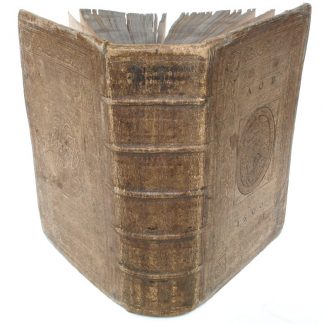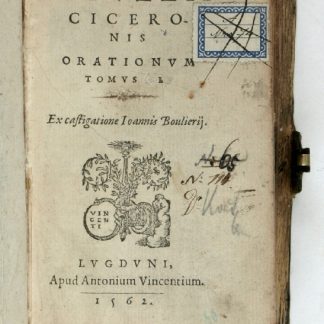Splendid imitation Grolier binding by Hagué
Institutiones. (Comm. Franciscus Accursius).
Folio (234 x 351 mm). 90 ff. (first and last blank). Gothic type, 2 columns, 81 lines, headings printed in red. One pink, white, and gilt initial painted on the first text page; red and blue Lombardic initials, rubricated throughout. Brown full calf by Théodore Hagué on bevelled wood boards, covers decorated with interlacing bands painted black and white and a network of gilt tendril designs with green leaves; central cartouches stamped "Io. Grolierii et amicorum" (upper cover) and "Portio mea domine sit in terra viventium" (lower cover). Spine on five raised bands, compartments decorated with gilt rules and floral designs coloured in white, green and black. Edges goffered, painted, and gilt. Stored in custom-made brown cloth case lined with white velvet, signed by Sangorski & Sutcliffe.
€ 35,000.00
Fine Koberger edition of the Institutes of Justinian, the students' textbook that forms part of the sixth-century codification of Roman law known as the Corpus Juris Civilis. Printed in red and black Gothic typeface with the gloss of Accursius, this rare edition from the press of Dürer's godfather is sought after for the high quality of its printing.
The present copy was bound, sometime in the 1880s, in a superb faux Grolier binding by the notorious forger Théodore Hagué (1823-91). Hagué had been trained at Reims by the master Jean-Baptiste Tinot whose speciality was, according to his advertisement, the "reproduction of antique bindings of all periods". In 1858 he relocated to London, where he worked in the workshop of Joseph Zaehnsdorf (1816-86), bookbinder to the King of Hanover, who produced bindings "in the Monastic, Grolier, Maioli and Illuminated styles". It was there that Hagué met the famous bookseller Bernard Quaritch as well as Guillaume Libri, who guided him in the restoration of authentic Renaissance bindings.
On his return to France at the end of the 1860s, Hagué began restoring old books and making fake bindings. His clients at that time included Joseph Renard and Ambroise-Firmin Didot. After the Franco-Prussian War he escaped his creditors to Brussels, where he set up his workshop under the name of "J. Caulin" and made many bindings in the 16th century style, which he offered to Quaritch as authentic. Indeed, towards the end of the 1880s Quaritch became doubtful of their authenticity and returned an exemplar with the arms of Catherine de' Medici that seemed recent to him. Hagué passed away in Normandy in 1891 (cf. Fontaine).
In the 1880s Quaritch sold several of Hagué's bindings to Charles Fairfax Murray, but after 1885 the businessman John Blacker (1823-96) became his sole customer for these bindings. In all, Blacker acquired 109 Hagué-bound books; their supposedly prestigious provenances included Jean Grolier, Thomas Mahieu, Anne de Montmorency, François I, Henri II, and Diane de Poitiers.
This specimen is one of those acquired by Blacker, described as no. 59 of his 1897 sales catalogue. One of no fewer than eleven fake Grolier bindings in his collection, it reproduces a painted interlacing decoration typical of those made in the 1550s by the royal binder Gomar Estienne. In the centre of the upper cover is Grolier's supralibros "Io Grolierii et amicorum" (usually placed near the bottom edge in authentic bindings); the lower cover bears Grolier's motto, "Portio mea Domine sit in terra viventium" ("Be Thou my portion, o Lord, in the land of the living", quoted from Psalms 142, verse 5).
A 16th century woodcut pasted to the blank space above the text on the first text leaf. First and final gathering very slightly misaligned, but altogether a complete and very well preserved copy in a splendidly notorious binding.
Provenance: 1) 18th century handwritten ownership "Teige" on first blank, obscured by a black stamp; 2) John Blacker (Sotheby's, Catalogue of a Remarkable Collection of Books in Magnificent Modern Bindings, 11 Nov. 1897, no. 59); 3) the library of the French numismatist Jean-Baptiste Colbert de Beaulieu (1905-95, his bookplate); 4) collection of Jean Marcel Stefgen (1927-2017, his bookplate).
HC 9519. Goff J-529. GW 7614. BMC II, 430f. Proctor 2055. BSB-Ink C-651. Cf. J. P. Fontaine, Nouvelles découvertes sur le relieur Théodore Hagué (2013).













